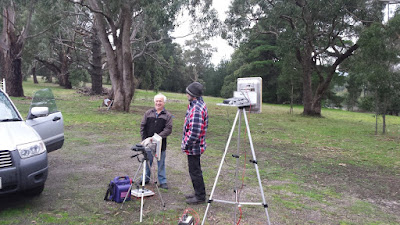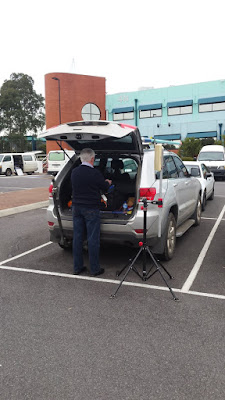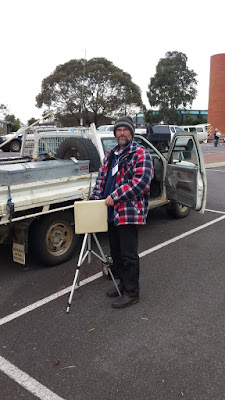A good day with good weather and high visibility made for good microwave activity, I went to location just east of Lithgow, (33.4859 S, 150.1886 E QF56CM at 1141m ASL, along with Dom VK2JNA and Geoff VK2AVR. We first worked Justin VK2CU/p at Mt Lambie (33.4716 S, 149.9881 E, QF46XM at distance of 21km bearing 272deg, 60/9 signal on FM on 3400.1 MHz.
Then we tried to work Kim VK2ASY/p at the Pinnacle Lookout, (33.3437 S, 149.0289 E, QF46MP, south west of Orange and near to Mt Canobolis, at height of about 1150m ASL bearing 277deg, a distance to us of 108km, but unsuccessful in receiving Kim or Kim receiving us. Kim did receive Justin VK2CU over at Mt Lambie, a distance of about 87km between them. Might have been a power output problem for Kim's transmitter.
Then we made contact with Matt VK2DAG/p and Dave VK2JDS/p at Gowan (33.1468 S, 149.3541 E, QF46QU at 1000m ASL bearing 296deg and distance of 85km, successfully working both at signal of 50 on USB, on 3400.1 MHz, with fair bit of QSB,
All stations using the GARC 3.4 GHz panels, except for Justin who had a 3.4 Ghz panel plus a 3.4 Ghz Minikits xvter, but it was not working too well on TX.
Contacts made between 0400 utc to 0500 utc
3.4 GHz panel with FT-817ND aimed at Justin VK2CU at Mt Lambie QF46XM
Geoff VK2AVR and Dom VK2JNA portable at QF56CM 1141m ASL very pleased to make some 3.4 GHz contacts.
Dom VK2JNA and Geoff VK2AVR portable at QF56CM 1141m ASL
3.4 GHz panel with FT-817ND aimed at VK2DAG and VK2JDS portable Gowan QF46QU
We running 2w from the FT-817ND into the transverter panel, an IF of 444.1 MHz = 3400.1 MHz tp produce less than 1w output.
Dom and Geoff continued the afternoon by perusing some more potential microwave sites, next time we we do a microwave day we will bring 1.2 GHz and 10 GHz gear.
I looked at a location on the way back towards Bell, along Chifley Road, at QF56DM, (33.4941 S, 150.2675 E, 1130m ASL) a good clear, high spot that would give takeoff back to Somersby (Central Coast through Newcastle) so we could work Gary VK2KYP from here.












